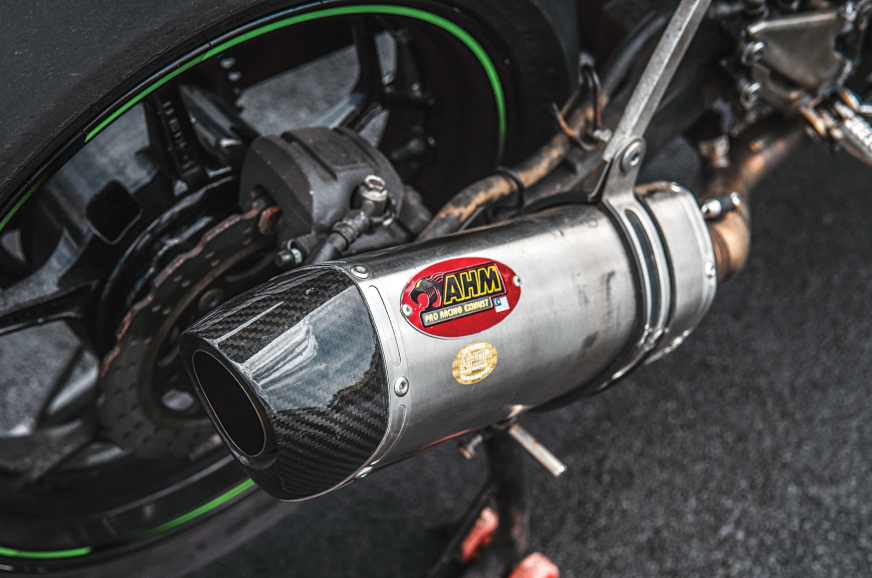It’s remarkable what a few tweaks can do in improving a motorcycle’s abilities on a racetrack. I got to experience this first hand at the Rajini Academy of Competitive Racing (RACR), last November, when they let me borrow their track-ready Kawasaki Ninja 300 for the weekend.
The Ninja 300 is now an old motorcycle and ours is one of the last few markets it was sold in - a BS6 version is being readied as we speak. In its time though, the baby Ninja was a rather versatile specimen even right out of a showroom. But, in its stock form, it wasn’t ideal for the racetrack. The team at RACR have done an impressive job in altering those aspects, turning it into an exciting on-track machine.
I didn’t have the opportunity to ride a stock Ninja 300 back-to-back and compare where the changes are most apparent, but I can safely say that this race-spec Ninja is a quick little thing - one that’s certainly quicker than the stock bike. How can I say for sure? Firstly, there’s a notable chunk of weight that’s been shaved off. Anything that isn’t required on a racetrack - the lights, pillion seat and that large eye-sore of a grab rail from the stock bike - has been stripped away. The bike hasn’t been weighed for an exact number, but I’ve been told it weighs about 10-15kg less than the stock bike, which, for reference, has a kerb weight of 179kg. As a result, the bike feels extremely easy to tip into a corner; a little too easy, in fact. There’s very little weight at the front and just one corner in, I realised it required very little input to get the bike to lean over. Owing to this reduced weight at the front, I also felt like an unnecessary input mid-corner would unsettle the bike quite a bit, so it was crucial that I was deliberate, but smooth, with my actions.

The added agility is also enabled by a recalibrated suspension set-up. The bike retains essentially the same suspension hardware, but a higher-viscosity oil and altered internals in the telescopic fork allow for a stiffer, more track-oriented ride. The team at RACR has made changes to the ergonomics as well. The stock Ninja 300 had an almost sport-tourer-like riding position that wasn’t nearly as aggressive as some of its fully faired rivals. On the race bike, the handlebar remains in its stock position, but the addition of rearset foot pegs have gone a long way in aiding its ergonomics on track. It still doesn’t put you in a very aggressive riding position, but it’s enough to establish a firm connection with the motorcycle and what’s happening under you.
Further aiding its handling is the choice of rubber. The bike now runs on Dunlop Sportmax Alpha-13 SPs at either end - a notable step up from the MRF Nylogrip Zappers on the stock bike. Our time at Kari also saw some rain and the tyres held up decently well, despite the fact that the track wasn’t always in perfect riding condition.
This particular bike has been developed solely for use at RACR’s track days and training sessions, so the modifications are not restricted by the regulations of the FMSCI. Despite this, the team has kept modifications to the high-revving engine fairly straightforward, limited to a reflashed ECU, an aftermarket exhaust from AHM, and a front sprocket that’s smaller by one tooth. These changes result in stronger acceleration at the compromise of top speed and a quick-throttle system makes it much easier to get going even with the slightest twist of the wrist. Despite the smaller front sprocket, this Ninja still climbs quickly past 140kph down the now-shortened main straight at Kari. However, it’s at the end of it where another aspect of its modifications became obviously apparent - the brakes.
The stock brake pads have given way to performance units from EBC and the system also uses steel-braided lines for better and more consistent braking. This combination results in extremely sharp braking and I was taken aback by how well they performed, the first time I was hard on the brakes. That’s probably why the guys behind the bike’s development decided against upgrading the master cylinder as well.
Lastly, there are some cosmetic changes as well. The front and side fairings have been replaced by the ones on the Ninja 400. The team opted to do so because they felt it had a better aerodynamic profile. I wholly agree with their decision because, in the RACR Castrol Power1 Racing livery, it looks stunning.
I only got a few fast laps on the bike, owing to the academy’s tight schedule. But, it was enough for me to realise that a decently powerful motorcycle and some rather inexpensive modifications are all you need if you’re looking to spend some quality time on a racetrack. It’s not a scary amount of power to get started on, but there’s also enough performance in there for you to have a smashing good time.
Also see:



